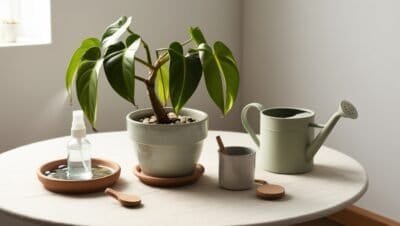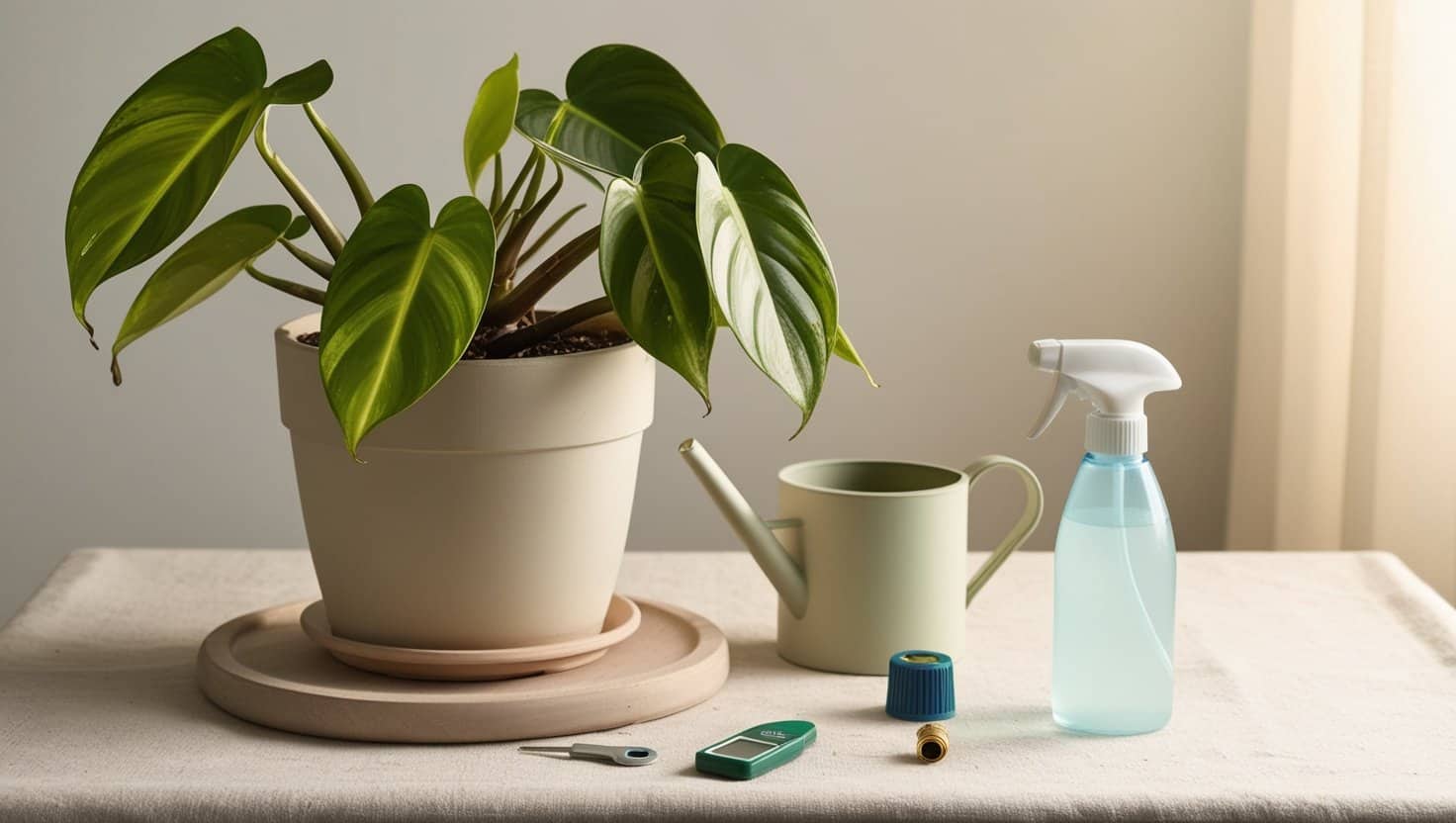For many plant parents, the drooping leaves of their beloved philodendron can come as a concern. These lovely houseplants, admired for their full green foliage, often experience downturned leaves due to common issues like watering habits or low humidity. However, all is not lost. As plant experts observe, one need only pay close attention to the unspoken communication of a philodendron’s wilting leaves to discover what may be lacking in its care. So before taking drastic measures, consider checking your plant’s hydration schedule or the moisture level in its environment. By addressing its basic needs, this hardy indoor foliage may spring back to life. The rest of the story contains guidance to help your philodendron thrive once more. Keep reading for steps to revive your plant’s cheery disposition!
Key Takeaway
- Drooping leaves can indicate your philodendron needs more watering or has too much water.
- Maintaining high humidity levels is important for a thriving philodendron.
- Light conditions and temperature greatly impact your plant’s health and happiness.
Why Is My Philodendron Drooping?
Common Causes of Drooping
It’s always concerning when your green houseplant friends start to look droopy and sad. Their wilting leaves may be trying to tell you something important. Understanding the main causes of drooping in philodendrons can help you be a better plant parent.
Water is super important for these tropical beauties. Giving them too little water or too much can both make them frown. It’s important to check the soil regularly and only water when it starts to feel a little dry. Too much wet soil can make the roots soggy and sad.
Philodendrons love warm, humid places because that’s where they’re from in nature. In winter, the dry air from heating can cause a philodendron’s leaves to hang their heads. Putting a pebble tray with water under the pot adds moisture back into the air. Using a humidifier is another good way to keep things nice and humid for your philodendron.
These plants prefer consistent temperatures. Big swings between hot and cold aren’t fun for anyone! Keeping your philodendron away from drafts and heaters helps give it stable conditions. That way it doesn’t have to stress out over temperature changes.
Taking time to understand your plant’s water, humidity and temperature needs will help keep its leaves looking perky and green. Working together, you and your philodendron can be happy plant pals for many growing seasons to come!
Signs of Watering Problems
It’s always good to know what your plant pals are trying to communicate through their leaves. For philodendrons, the signs of underwatering versus overwatering are important to understand.
When a philodendron doesn’t get enough water, its leaves will let you know. They might look sad and floppy, or feel dry and crinkly. In really thirsty plants, the leaves sometimes curl at the edges or turn brown and drop off. You’ll also notice that the soil is bone dry.
But too much water can cause problems too! An overwatered philodendron may have yellowing leaves. Sometimes the leaves droop like they’re sad. And the soil gives it away – it will smell musty because it stays soggy and wet.
Checking both the leaves and soil regularly can help you spot what’s going on. By catching the signs early, you’ll be able to adjust your watering routine. That way the roots stay healthy and happy. With a little practice, you’ll be able to speak “leaf” and keep your philodendron thriving for years to come!
Solutions to Revive Your Philodendron

If your poor philodendron is looking droopy and sad, there’s hope yet! Just follow these easy tips to help your plant friend feel better.
First, check how often you’ve been watering. Stick your finger in the soil and see if the top inch feels dry. Water only when it’s a little thirsty. And be sure your pot has holes on the bottom so extra water can drain out. Dry soil is what philodendrons like best.
To make things cozier for your plant, give it more humidity. We all feel better when the air is nice and moist. You can put a pebble tray filled with water under the pot to raise the humidity. Or try misting the leaves sometimes with a spray bottle.
Offer your philodendron stable temperatures too. Pick a spot away from drafts and vents where it won’t get too hot or cold. Constant conditions help us all relax.
With some TLC like this, your philodendron’s leaves should start looking greener and perkier in no time. Now get out there and save that droopy plant-pal of yours!
Nutrient Imbalance and Repotting Shock
It’s important for your philodendron’s health and happiness to meet its nutritional needs. However, too much of a good thing can cause problems too.
Providing fertilizer at the right time is key – during the growing season only, and following instructions carefully. Too much fertilizer salts in the soil can stress out plants, leaving them looking droopy and sad. If this happens, a good flush with water can help rinse away what’s making them frown [1].
Even repotting, which is meant to help, can give a philodendron a scare! When changing their soil home, it’s best to handle roots gently so they don’t get shaken up. Drooping may occur after repotting due to the disruption. Keeping conditions consistent after helps them settle in at their new place.
Knowing what could be throwing off their nutrient balance or startling them with change allows you to care for their physical and emotional needs. With understanding and patience, their leaves will perk up in no time!
Light and Pest Considerations
Light is important for your philodendron friend to stay peppy, but too much sun can feel stressful. They prefer calm, indirect light that doesn’t scorch their leaves. Make sure your plant pal isn’t getting sunburned or is staying too hidden in the shade. Check that it’s getting the “just right” amount of sunshine by adjusting its spot if needed.
Keeping an eye out for tiny visitors is also key. Little bugs like spider mites or aphids could upset your plant by nibbling or sucking away at it. If any creepy-crawlers are seen, take swift action before they cause your philodendron to droop down sadly. Neem oil works as natural bug spray that won’t hurt your leafy pal. Early treatment will help it stay healthy and strong.
With goldilocks-just-right light and regular checkups for bugs, your philodendron will be green and growing for a long time to come!
Immediate Steps to Take
Your tired philodendron is sending SOS signals with its droopy leaves. Let’s hurry to the rescue with some fast fixes!
The very first step is to give the soil a feel. Water if it’s dry like a bone, or let it dry out if soggy. Next, create a spa day for your plant by raising the humidity around it. No one feels good in dry air. Then make sure temperatures are stable so it doesn’t get hot or cold stressed.
Check on the light too – is your leafy friend getting too much sunburn or hiding in shade? Adjust as needed.
With these quick tune-ups of water, humidity, temperature and light, your philodendron’s branches will perk up like new. It’ll feel peppier and keep you from worrying in the future. Your green pal will be so relieved – and you’ll be proud to see it healthy again!
Understanding Philodendron Care
While philodendrons are low-maintenance plants, they still need some TLC from their plant parents. Here are a few tips:
Use a potting soil that drains well to keep roots happy and healthy. A good mix has fluffy pieces like peat moss or perlite to allow water movement. Changing the soil gives philodendrons a nice fresh start [2].
Water just when the top inch of earth looks dry – not too much, not too little. This prevents soggy roots but also helps keep your plant friend properly hydrated.
Philodendrons love calm, bright light near a sunny window. If the leaves start looking pale, it may need a spot with a bit more natural light shining through.
By paying attention to soil, watering habits and placement needs, their beautiful foliage will thrive for you to enjoy. A little care ensures your philodendron sticks around for many seasons of growth.
FAQ
What are the most common reasons my philodendron’s leaves are drooping?
The most common reasons for drooping leaves include improper water (either too much or completely dry soil), poor light conditions, and low humidity levels. Like many tropical plants from South America, philodendrons need a sweet spot of care to thrive. Keep an eye on soil moisture and ensure proper air circulation to prevent issues.
How can I tell if I’m overwatering or underwatering my philodendron?
Check how the soil feels – if the top inch of soil is dry, it’s time to water thoroughly. With excess water, you risk root rot, which can make leaves drooping worse. For a quick check, stick your finger into the soil – if it’s dry 2 inches down, water it. If it feels soggy, let it dry out.
Why are my philodendron leaves turning yellow or brown?
When leaves turning yellow or brown appear, it often signals care issues. This could be from direct sunlight burning the leaf tips, poor drainage hole setup, or air conditioning affecting humidity levels. Unlike low maintenance plants like the snake plant or peace lily, philodendrons need more specific care.
What light conditions do philodendrons need to prevent leggy growth?
Philodendrons love bright indirect light in your living room or any indoor space. During winter months, you might need grow lights to prevent leggy growth and maintain healthy growth. While they can handle low light better than many indoor plants, too little light affects the plant’s ability to thrive.
How can I revive a wilting philodendron and ensure proper root growth?
Start with a step guide: check for fungal diseases, assess root system health, and consider transplant shock if you recently move the plant. Refresh with fresh soil if needed, avoid tap water (use filtered), and maintain high humidity. The leaves and stems should perk up once you address these factors.
Conclusion
Drooping leaves on a philodendron can cause worry for owners. With careful attention though, these popular plants can bounce back. By inspecting watering habits and environmental conditions, any issues with moisture, temperature or light exposure may become clear. Small adjustments like providing humidity, drainage, or placing the plant in a more suitable spot can work wonders. With some TLC from observant plant parents, philodendrons will regain their lush foliage once again and continue brightening up the home for years to come.
References
- https://microveggy.com/why-are-my-philodendron-leaves-drooping/
- https://thegardengeeks.com/plant-care/indoor/why-is-my-philodendron-drooping/
Related Articles
- https://knowngarden.com/philodendron-soil-recipe/
- https://knowngarden.com/philodendron-birkin-yellow-leaves/
- https://knowngarden.com/my-philodendron-is-wilting/

